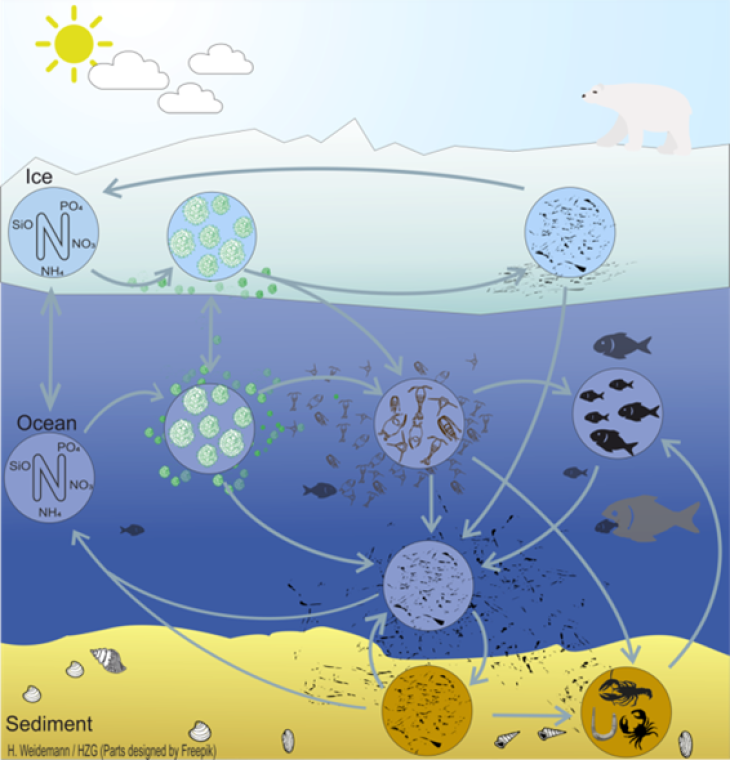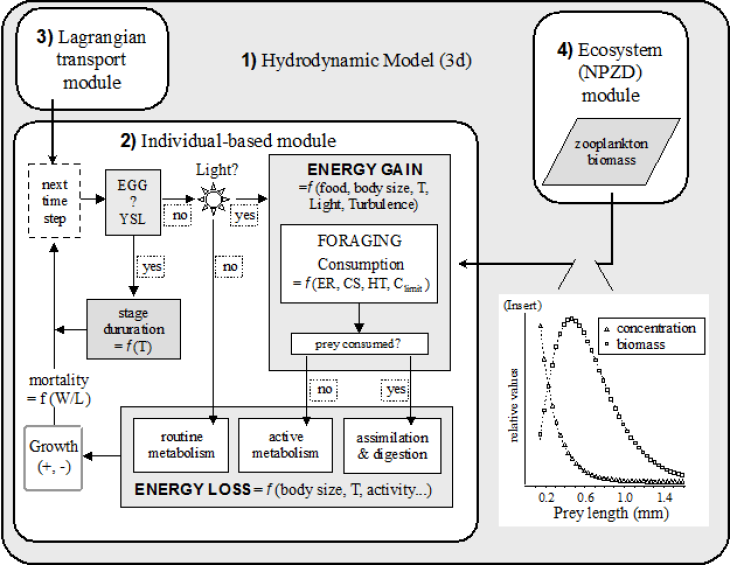GCOAST Modellsystem
COSMO-CLM (CCLM)

Grafik: M. Mathis/ Hereon
COSMO-CLM (CCLM) ist ein nicht-hydrostatisches, flächenbegrenztes Atmosphärenmodell (Rockel et al., 2008). Das Modell COSMO (cOnsortium for Small-scale mOdeling) wurde ursprünglich vom Deutschen Wetterdienst (DWD) in den 2000er Jahren als Modell für die Wettervorhersage mit begrenztem Gebiet entwickelt. Später wurde es in der Climate Limited-area Modeling Community (CLM-Community) zum regionalen Klimamodell COSMO-CLM weiterentwickelt. Im Dezember 2021 wurde COSMO v6.0 veröffentlicht, die letzte Version des COSMO-Modells. Mit dieser Version endet die Entwicklung des COSMO-Modells nach mehr als 2 Jahrzehnten. Das Nachfolgemodell von CCLM ist die räumlich begrenzte Version des Icosahedral Nonhydrostatic (ICON) Modells (ICON-CLM).
TOCMAIM (Total Organic Carbon–Macrobenthos Interaction Model)

The model has been applied to the North Sea to investigate the spatio-temporal variability of macrobenthic biomass, sediment OC storage, benthic oxygen consumption and human impacts on sedimentary carbon storage. © 2024, Zhang, W. et al., CC BY 4.0. https://doi.org/10.1038/s41561-024-01581-4
TOCMAIM (Total Organic Carbon–Macrobenthos Interaction Model) is developed at Hereon to resolve the interactions between benthic fauna and early diagenesis of organic carbon (OC). Sedimentary OC is divided into three pools depending on its degradability: labile, semi-labile, and refractory. With a Neumann boundary condition of OC fluxes at the sediment–water interface calculated by the pelagic model component (ECOSMO), sedimentary OC content is solved by a mass balance equation in TOCMAIM, taking into account the impacts of oxygen-dependent first-order degradation, macrobenthic uptake, respiration and bioturbation. Temporal change of macrobenthic biomass is calculated on the basis of food availability in the form of OC, temperature, oxygen, and mortality caused by predation and bottom trawling. Bioturbation scales with macrobenthic biomass and is inversely related to local OC resource. Oxygen penetration depth is jointly determined by physical (sediment permeability, porosity, bedform and bottom current velocity) and biogeochemical (carbon remineralization) parameters. TOCMAIM is integrated into the sediment module (MORSELFE) of the 3D hydro-morphodynamic model SCHISM, so that the information of erosion/deposition calculated by the hydro-morphodynamic model can be directly transferred to TOCMAIM to update the fluxes
Globales hydrologisches Modell (HydroPy)
HydroPy (Stacke und Hagemann, 2021) ist ein modernes globales Hydrologiemodell, für dessen Aufbau keine Modellkalibrierung durchgeführt wurde. HydroPy benötigt in der Regel tägliche Eingabefelder für Niederschlag, 2m-Temperatur, abwärts gerichtete kurzwellige und langwellige Strahlung, 2m-spezifische Luftfeuchtigkeit, Oberflächendruck und 10m-Wind aus dem jeweiligen Forcing-Datensatz. Es gibt jedoch auch die Möglichkeit, nur den Niederschlag und die 2m-Temperatur zu verwenden. Vor kurzem wurde das Modell mit einer ersten Implementierung zur Berechnung der Stickstoffeinträge in Flüssen ausgestattet.
Der Modellcode und weitere Informationen sind verfügbar unter
https://doi.org/10.5281/zenodo.4541380


